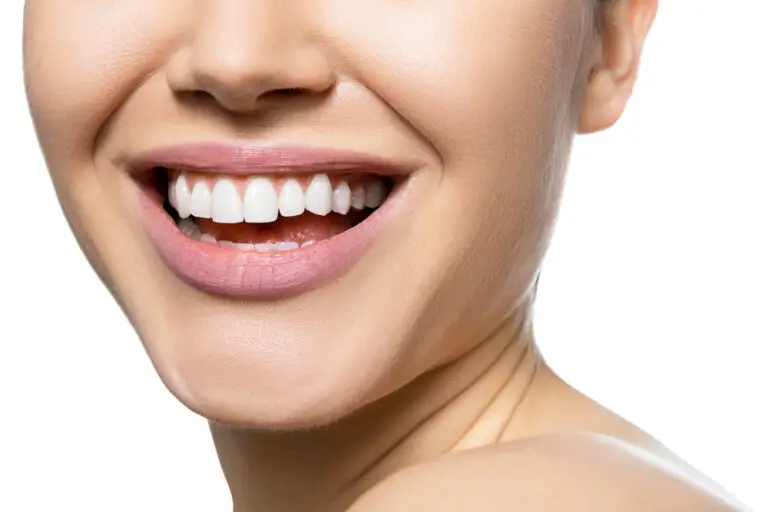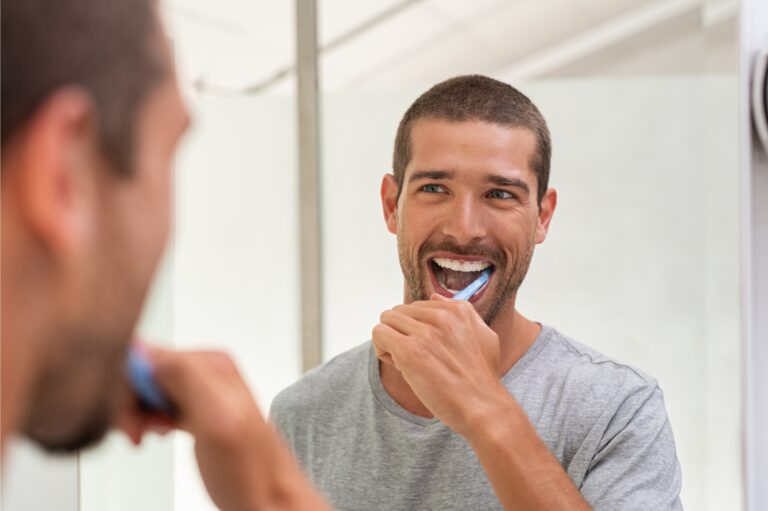Having braces can make it more challenging to whiten your teeth. With a metal brace covering each tooth, there is less exposed tooth surface to whiten. However, there are still effective options to safely brighten your smile while wearing braces.
Why whitening with braces is tricky

Braces are glued to the front surface of your teeth using a dental cement. This adhesive is carefully applied to maximize durability of the brackets on teeth over the course of orthodontic treatment, which may last 1-3 years.
With brackets bonded to each tooth, only a small strip of exposed enamel remains visible along the gumline. Any whitening products applied to the teeth cannot directly reach or treat the covered surfaces.
Attempting whitening around braces also risks irritation or damage to the gums and other soft tissues of the mouth. These areas are more vulnerable to chemical burns from whitening agents because the metal brackets leave them more exposed.
Excess whitening gel that leaks under or around braces can burn gums, lips, cheeks and tongue tissue. Damaged gums may also recede or become inflamed, which can indirectly affect the positions of teeth.
Therefore, whitening methods need to be carefully adapted and used in moderation to avoid complications while braces are worn. But with the right approach, you can still enjoy a visibly whiter smile throughout orthodontic treatment.
Effective whitening options with braces

Here are the best methods and products to safely whiten teeth while wearing fixed braces:
1. Whitening toothpastes
Whitening toothpastes gradually lift stains from the teeth through the use of gentle polishing agents and low concentrations of chemical whiteners. They are safe for daily use alongside orthodontic appliances.
Look for toothpastes containing ingredients like:
- Silica – a fine polishing powder that helps buff away extrinsic stains on the outer enamel layer. Higher silica content provides more polishing action.
- Sodium pyrophosphate – a scaling agent that helps prevent calculus buildup and remove debris.
- Hydrogen peroxide – an oxidizing bleaching agent that penetrates the teeth to lift intrinsic discoloration. Concentrations under 3% hydrogen peroxide are safe for daily use.
- Papain and bromelain – natural enzymes extracted from papaya and pineapple. They help break down and digest pigmented molecules adhered to the tooth surface.
With consistent use, brushing properly with a specially formulated whitening toothpaste can lighten teeth 1-2 shades over a course of 2-4 weeks. However, results may vary based on factors like initial tooth color and staining habits.
2. Whitening mouthwashes
Whitening mouthwashes offer a simple way to help lift stains from around braces. They contain either low percentages of hydrogen peroxide or natural mild whitening agents like lemon juice.
These mouthwashes work through circulation in the mouth and direct contact with the exposed tooth surfaces. Swish the mouthwash vigorously around all teeth and braces for the manufacturer’s recommended length of time.
It’s important to spit it out completely afterwards and avoid swallowing the whitening solution. Used 1-2 times daily after brushing, whitening mouthwashes can gradually lighten exposed stained areas not covered by braces.
3. Rub-on whitening gels
Specialized whitening gels for application directly to the teeth may also be used safely with braces. These products come in small syringe-like tubes for targeted gel application.
The thin nozzle tip allows you to squeeze small amounts of gel directly into the narrow gaps along the gumline not covered by brackets. Look for gels containing 5-15% carbamide peroxide or 3-10% hydrogen peroxide as the active whitening ingredient.
Apply the gel to indicated areas of teeth for 5-10 minutes 1-2 times per day. Use these products regularly until you’ve reached your desired level of tooth whiteness. Rinse thoroughly after each application to prevent tissue irritation.
4. Whitening strips
Whitening strips that adhere directly to the teeth, like Crest Whitestrips, can potentially lighten the thin exposed band of enamel along the gumlines beside braces.
However, applying whitening strips correctly around orthodontic brackets is very challenging. The strips are likely to overlap onto gums, causing significant irritation and pain.
For this reason, whitening strips are generally not recommended while braces are worn. The risks of chemical burns from improper strip placement usually outweigh the minimal whitening benefits.
5. At-home whitening trays
Custom-fitted whitening trays allow for closer contact between the peroxide gel and tooth surfaces. But trays are extremely difficult to properly fit over braces, with their bulky brackets and archwires.
Specialized trays may work if precisely tailored around the braces. But this would require repeated impressions and tray adjustments by a dentist throughout treatment as braces are adjusted.
Ill-fitting whitening trays also have potential to leak hydrogen peroxide gel onto gums or soft tissues, causing painful burns and damage. Discuss tray whitening options carefully with your orthodontist first if interested.
6. In-office whitening
Under professional supervision in the dental office, higher concentration hydrogen peroxide gels (up to 35%) can be applied to the teeth for rapid whitening.
The dentist will first isolate and protect the gums from irritation before brushing the whitening gel onto the limited exposed tooth surfaces not covered by braces.
However, because so little enamel area is accessible with braces on, in-office whitening may provide only subtle improvement. Discuss with your dentist if this intensive option is recommended for your situation. Take proper precautions if pursuing in-office whitening with braces.
7. Post-braces whitening
Once orthodontic appliances are removed after completing treatment, the teeth may exhibit demineralized white spots or dull grayish stains under areas where brackets were bonded.
At this point, professional teeth whitening is recommended to brighten your smile and even out these discolorations across all teeth. Popular post-braces options include in-office whitening, custom trays with concentrated peroxide gel, or Crest Whitestrips.
Timing whitening procedures for right after debonding braces allows for dramatic results, since all tooth surfaces are newly exposed and can be treated. This helps compensate for any stains that developed and were hidden underneath braces for months or years.
Tips for safe whitening with braces

Keep these precautions in mind when using any whitening methods in conjunction with fixed orthodontic braces:
- Consult your dentist before applying any new oral hygiene products or whitening agents. Ensure the chemicals will not interfere with your specific braces or dental work.
- Closely follow all instructions for application times and frequency of use. Overusing whitening products increases risks of side effects like tooth sensitivity or gum irritation.
- Thoroughly rinse off any whitening gel, strips or solution after the recommended duration of contact with teeth. Residual agents left sitting on teeth or gums can cause tissue burning.
- Avoid using whitening strips around braces as much as possible. Their lack of adjustability makes them likely to overlap and damage soft tissues.
- Dry teeth thoroughly before applying any rub-on whitening gels into crevices around braces. Moisture contamination on the enamel surface reduces gel effectiveness.
- Monitor for gum sensitivity when using peroxide-based whiteners. Discontinue use if any discomfort, whitening or recession of gums occurs.
- Maintain excellent oral hygiene to prevent gum inflammation around braces that could be aggravated by whitening agents. Brush and floss carefully after applying products.
- Avoid highly colored foods and staining beverages for 24-48 hours after whitening while the effects are fresh. This prevents stains from quickly returning.
- Plan periodic touch-up whitening as needed if stains return over the course of orthodontic treatment. Repeated applications are safe if properly timed.
Frequently Asked Questions about whitening with braces
Q1: Is whitening safe with braces?
Whitening teeth around braces is generally safe provided products are selectively used in moderation as directed. However, consult your dentist to determine the safest options for your unique orthodontic situation.
Q2: Which whitening methods are not recommended with braces?
Avoid using whitening strips, which are difficult to properly apply without touching and irritating gums. Over-the-counter prefabricated whitening trays are also generally ineffective unless custom-fitted by a dentist.
Q3: Can I whiten my teeth immediately when I get my braces taken off?
It’s best to wait at least a few days after brace removal to allow the teeth and gums to start healing before pursuing intensive whitening procedures. Mild daily products like whitening toothpaste are safe to use right away.
Q4: How white can I realistically get my teeth while braces are still on?
Most at-home whitening techniques will only provide subtle improvements, lightening teeth 1-3 shades over a few weeks of use. For more dramatic brightening, wait until after braces come off to use stronger in-office or custom tray methods.
Q5: What’s the best way to prevent stains on my braces?
Avoid excess consumption of dark-colored foods and staining beverages like coffee, tea, wine or soda. Brush diligently after meals and use whitening toothpastes or mouthwashes daily. See your dentist regularly so braces can be adjusted and teeth professionally cleaned.
Conclusion
Although braces can limit certain aspects of teeth whitening, there are still safe and effective options to enhance your smile. Use mild over-the-counter whitening products daily alongside proper oral hygiene practices. For optimal brightening results, consult your dentist about professional solutions that can be applied once braces are removed. With strategic timing and care, you can still successfully whiten your teeth during orthodontic treatment.






